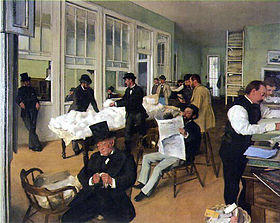
In the Pre-Civil War South, most cotton planters relied on cotton factors (also known as cotton brokers) to sell their crops for them.
This factor was usually located in an urban center of commerce, such as Charleston, Mobile, New Orleans, or Savannah (harbor cities; there was not yet a network of railroads), where they could most efficiently tend to business matters for their rural clients. Prior to the American Civil War, the states of Alabama, Georgia, Louisiana, and Mississippi were producing more than half of the world's cotton, but Arkansas, Tennessee, and Texas produced large amounts also.[1] At the same time, the port of New Orleans exported the most cotton, followed by the port of Mobile.[2]
Cotton factors also frequently purchased goods for their clients, and even handled shipment of those goods to the clients, among other services.
As one source notes,
The factor was a versatile man of business in an agrarian society who performed many different services for the planter in addition to selling his crops. He purchased or sold slaves for his client, arranged for the hiring of slaves or the placing of the planter's children in distant schools, gave advice concerning the condition of the market or the advisability of selling or withholding his crop, and bought for his client a large proportion of the plantation supplies.[3]
Not all factors in the antebellum South were cotton factors; some were factors of other commodities. In 1858, for example, New Orleans boasted sixty-three sugar and molasses factors. Louisiana produced large amounts of sugar cane, but it probably had an even greater number of cotton factors.[4]
See also
- Factor (agent)
- Mobile Cotton Exchange
- New Orleans Cotton Exchange
- Edmund Richardson
References
- ^ Knut Oyangen. "American Agricultural History Primer: The Cotton Economy Of The Old South". Center for Agricultural History and Rural Studies. Iowa State University. Archived from the original on 25 November 2012. Retrieved 16 January 2011.
- ^ "Mobile as a Cotton City 1820-1860". Alabama Moments in American History. Alabama Department of Archives and History. Archived from the original on 28 September 2011. Retrieved 16 January 2011.
- ^ Clement Eaton, A History of the Old South (Prospect Heights, Ill.: Waveland Press, 1975), p. 230.
- ^ Clement Eaton, The Mind of the Old South (Baton Rouge, La.: Louisiana State University Press, 1964), pp. 46-47.